On Sunday, March 3, 2002, the drachma was used for the last time as legal tender in Greece, giving way to the euro the following day. Of course, the new currency was already in circulation since the New Year of 2002, but euro and drachma "walked" together for two months, until the Greeks adjusted to the new monetary reality.
In a way, a great cycle, which had started from the 7th BC, was closed. century and with several "breaks" it reached the beginning of the 21st century. Today, the Magazine , on the occasion of the completion of twenty years since the abolition of the drachma, remembers its most important stages in history.
HOW THE DRACHM WAS "BORN"
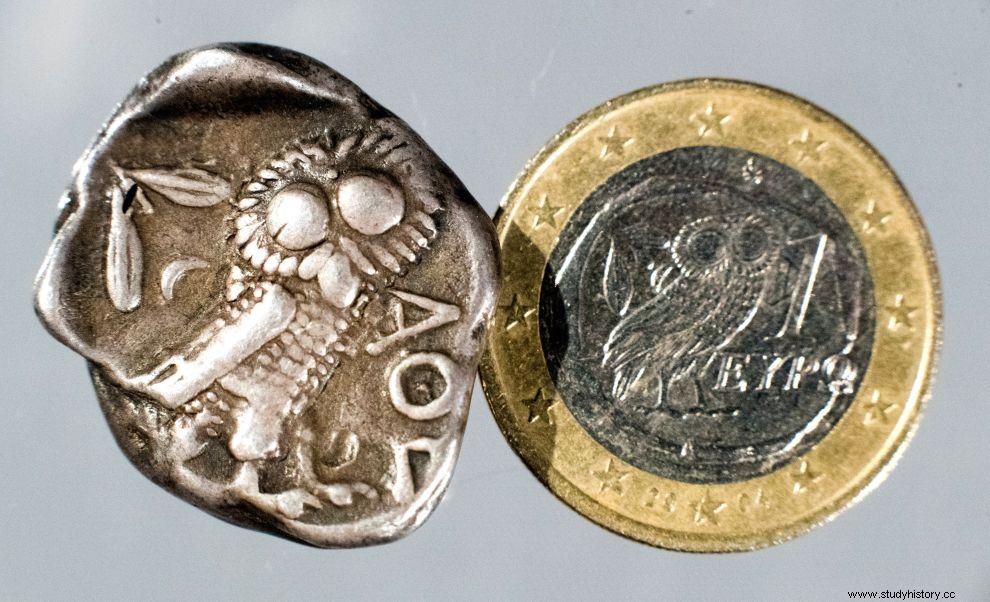
According to the historian Herodotus, the first coins in the ancient world - an alloy of electricity, our familiar amber - appeared in the early 7th century BC. century in Lydia, an ancient kingdom in Asia Minor, which in its full heyday covered the lands of today's central-western Turkey. These coins were in the form of pellets or tiles and very soon they began to be made of silver and gold, with a specific weight, which means that in addition to being a monetary unit, they were also used as a unit of weight.
But there were also coins of lesser value, the obolos, which were iron bars (the oldest obolos we know were found in Heraion of Argos and date from the 7th century BC). A man of normal size could hold six such rods in his hand. From the ancient verb dratto, i.e. to seize, to seize, the word drachma arose, which in essence was equivalent to six obols and developed into the basic transaction currency of the ancient Greek world.
Although there was no uniform standardization of the weight of coins throughout the Greek territory, a drachma had the following fixed relationship with the rest of the coin-weights of the same city-state:
- 1 drachma =6 obols
- 2 drachmas =1 stater
- 100 drachmas =1 mna
- 6,000 drachmas =1 talent
To give you an idea, at the time of Solon (early 6th century BC), a citizen in Athens could cover his expenses for a week with one drachma (six obolus). The two drachmas (twelve obols) had the value of a stater (from the verb isthimi which means to set something upright or to weigh). The stater in Athens, if it was silver, was equivalent to four drachmas and if it was gold, to twenty drachmas. The gold Persian stater (dareic) had a value of 28 drachmas.
THE APPEARANCE OF STATE COINS

Another basic currency was the mna, which corresponded to one hundred drachmae and according to Solon's legislation, was proportional to the fine that had to be paid by anyone convicted of rape. Finally, the silver talent (60 mnes), essentially six thousand silver drachmae (since talents were never minted because they were too heavy to use), was sufficient for the monthly wages of the 200 men manning an Athenian trireme during the Peloponnesian War (431 BC - 404 BC).
Originally, tiles and pellets, when they changed hands, had to be weighed because no one could guarantee that they were the correct weight of the metal they were made of (silver, gold, iron). Later, each city-state put its own seal on the coin as a guarantee. Finally, city-states began minting their own coins, putting their own seal on them and deciding on the representations on each side, resulting in the birth of state coins.
THE ATHENIAN TETRADRACHUM
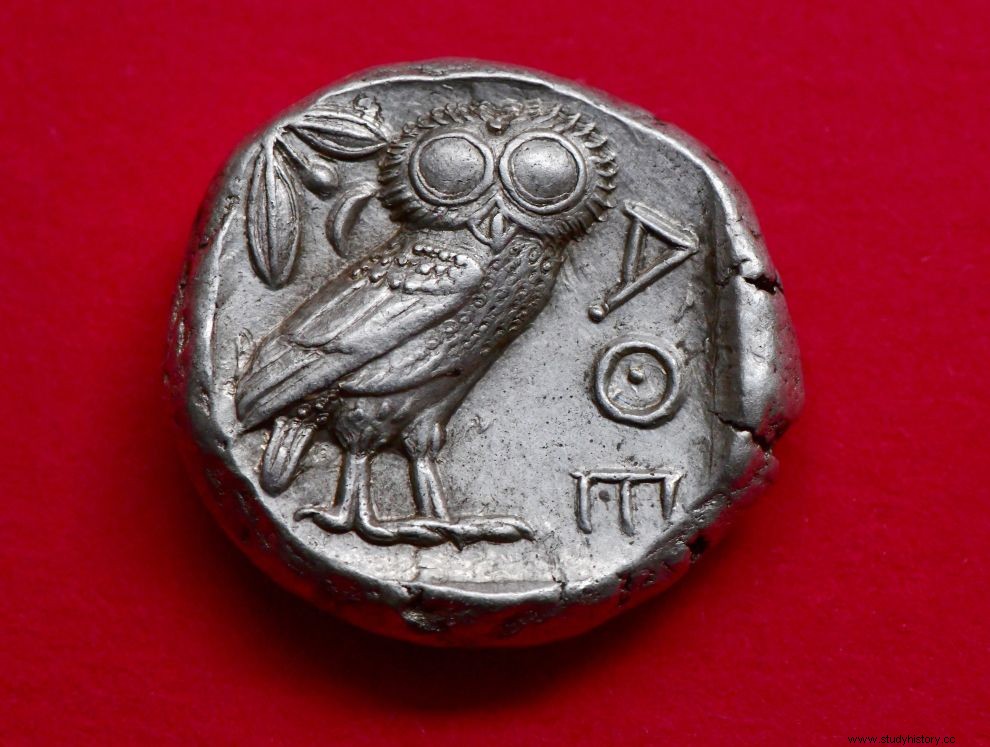
As we wrote at the beginning of the text, the first coins known to us were the Lydian ones and soon after the Ionian ones appeared (from Greek cities in Asia Minor), around 650 BC. A little later those of Aegina were released, followed by Corinth (600 BC) and then the Athenian ones. What is certain is that the Athenian silver tetradrachm was the most widespread coin of antiquity, from the beginning of the heyday of Athens in the 5th BC. century, up to the time of Alexander the Great, when Macedonian coins prevailed.
The Athenian tetradrachm was used in all transactions, even by city-states hostile to Athens. The great advantage of the Athenians was that they had at their disposal silver quarries, mainly that of Lavrio, so they could produce and circulate a large number of coins, which gave them such financial comfort that they could create large projects (Acropolis, Parthenon, fortification of the city, Long walls), but also to maintain a combat-worthy army and fleet.
On one side of the Athenian tetradrachm was depicted the head of the goddess Athena, while on the other, the symbol of the city of Athens, the "glaῦx" (owl) together with an olive branch. This coin was popularly known simply as "Athenian glaῦx". Twenty-five centuries later, the glauca of the Athenian tetradrachm is now depicted on the Greek national face of the one euro coin. According to Philochorus, an Athenian historian of the 3rd BC. century, the "glaῦx" was known throughout the ancient world and was trusted by all as a monetary unit.

As long as the Greek drachma was in circulation, it dominated the commercial space inside and outside the borders, since over the years the parity of the various currencies was consolidated in almost the entire territory known at the time. The Athenian tetradrachm was also adopted as a type of currency by the Greek colonies, but was replaced by the Macedonian tetradrachm at the time of Alexander the Great, when Macedonian coins prevailed, with the term "drachma" spreading outside the Greek world.
The great legacy left behind by the Macedonian soldier, as well as the legend that was created around his name after his early death, caused all his successors and descendants to continue minting drachmas depicting his image on them, with the result that this coin survived throughout the Hellenistic era. It is worth noting that Macedonian variants of the tetradrachm reached as far as central Asia and India.
Eventually the drachma began to gradually disappear as a currency after the Roman conquests and the predominance of the denarius as a monetary unit. Despite the fact that it was abolished as a currency, the word "drachma" continued to be used for many centuries in the Greek area as a unit of weight, with a subdivision of "grammas". At the end of the 17th AD century we also find it as "dram", while it is not at all improbable that the name dram came from there, which was a subdivision of the oka, a weight measurement used in Greece until 1959.
ROMANS, BYZANTIES AND OTTOMANS

With the advent of the Roman Empire, the drachma disappeared from the scene and other coins took its place. After the Roman denarius, followed Byzantium, with the gold coin of Emperor Anastasius (498 AD) called "nomisma" and the "tetartiron" of Nikephoros Phokas (963-969), which however had different real values, depending on when they were minted, since the emperors were constantly adulterating them, removing gold and silver from them.
After the fall of Constantinople by the Franks in 1204 and the fragmentation of the Greek territory into many smaller kingdoms, principalities, counties, despotates, etc., coins of Western origin appeared, such as ducats, skoudas, tournezias, giliatas and many others. This was followed by the fall of the Byzantine Empire from the Ottomans in 1453, and in the everyday life of the Greeks, the grosias and parades entered, while in 1822, with the Greek Revolution in full swing, 26 different coins were circulating in Greece, of which more than half were official coins of the Ottoman Empire.
THE FIRST ATTEMPTS TO RETURN THE DRACHMA

The need for the creation of a Greek national currency has been a common finding of the Greeks since the very beginning of the revolution. In March 1822, Dimitrios Kalamariotis, qualified from Messina and a member of the Peloponnesian Senate, was authorized by the Greek government to buy a "makina", a coin-cutting machine, that a coin maker had set up in Kardamili, Mani. The Monastery of Panagia Katakekrimmeni, outside Argos, was designated as the National Mint.
An Armenian named Kirkor (Gregory), surname unknown, was appointed engraver, while they collected gold and silver by melting down sacred vessels taken from churches. The Executive had decided that the first coins would be the pentadrachm and the obolo. Ultimately, however, the cutting was suspended, because in July 1822, Dramalis entered the Peloponnese with his army. When the Greek forces defeated Dramalis, the issue of currency returned to the fore, with the Parliament approving the minting of silver drachmas and oboles (each drachma would be equal to one hundred oboles).
"PHOENIX", THE CURRENCY OF CAPODISTRIA

Even then, however, the matter did not progress, since in 1823 the civil war broke out, while in 1825 Ibrahim landed in the Peloponnese. Finally the issue was left to the judgment of Ioannis Kapodistrias, who arrived in Nafplion in January 1828. The new Governor chose as the new national currency the silver "Phoenix", subdivided into minute (one palm=one hundred cents). In May 1828, Alexandros Kontostavlos, a member of the financial committee, bought in Malta a second-hand cutting machine, formerly belonging to the Knights of St. John, manufactured since the end of the 18th century.
Four more machines were then purchased, from Marseilles, Ancona and Syros, one for each coin (1 palm, 1 minute, 5 minutes, 10 minutes and 20 minutes) and all were installed shortly afterwards in the courtyard of Kapodistrias' house, in order to control the cutting process. However, the first coins of the new Greek state were minted in Aegina, where 2,500 years ago the first coins on European soil (silver staters) were minted. The first new coins were distributed to the members of the Fourth National Assembly on July 30, 1829.
SCREEN RETURNS DRACHM

Three and a half years later, in January 1833, King Otto arrived in Greece and a few days later, on February 8, with the royal decree "on the regulation of the monetary system", the phoenix was abolished and replaced by the drachma. Its return, revival and establishment was a clear attempt by the Greek state to connect the newly formed Greek state with the ancient Greek culture. The new coin weighed 4.477 grams, of which 4.029 was silver and 0.448 was copper. The Bavarian shield was depicted on one side and Othon on the other.
In August 1833 it was expressly forbidden to accept Turkish coins from public treasuries, in an attempt to impose the new currency. In March 1841, the National Bank of Greece was founded, which two years later (1843) was granted the privilege of issuing banknotes, which it maintained until 1927, when the Bank of Greece took over. In 1867, five years after the expulsion of Otto from Greece (October 1862), with George I now king, Greece signed an agreement with the Latin Monetary Union (France, Belgium, Italy, Switzerland), following the exchange rate rules of.
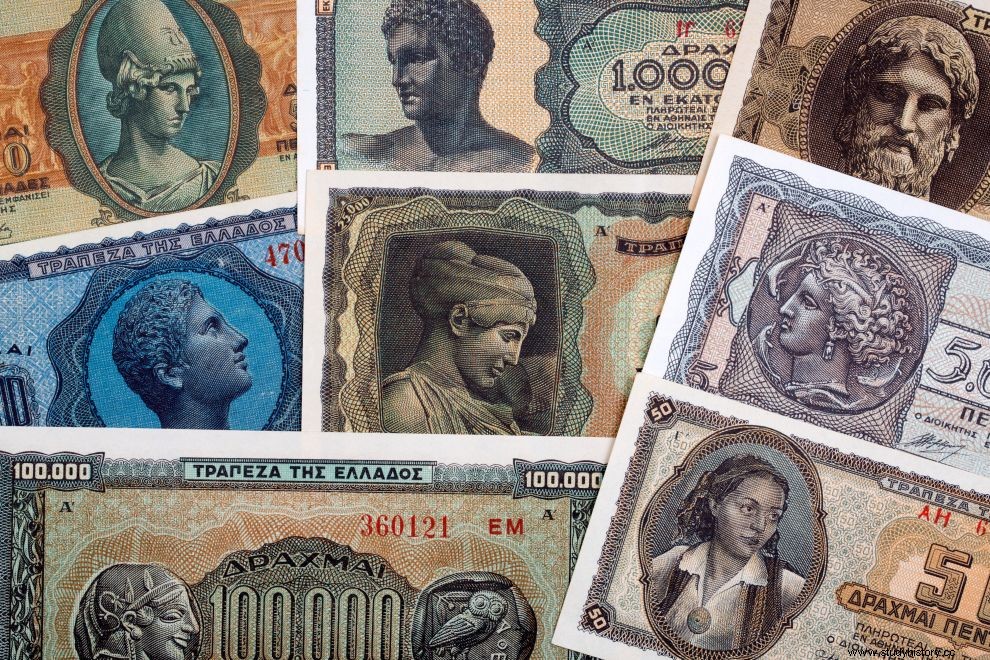
But due to the wars and the economic crisis that followed, the drachma was able to join the Union much later, in 1910. Upon joining, it was equalized with the other currencies of the Union, such as the French franc. In many editions of the National Bank banknotes, the nominal value on the reverse side was indicated in French francs. This is the most likely reason why, for many decades afterwards, the people called the drachma and the franc (the two drachmas a diprach, etc.).
On November 17, 1927, the Geneva Protocol was signed, with which the Bank of Greece was founded, now having the privilege of issuing banknotes. The drachma was pegged to sterling at a rate of 375 drachma/pound. With the decree of 7/12/1930, silver coins of 10 and 20 drachmas and nickels of 5 were issued. In 1933, the first 500 and 5,000 drachma notes printed on behalf of the Bank of Greece by the American Bank Company were released in USA.
THE OWNERSHIP DRACHES
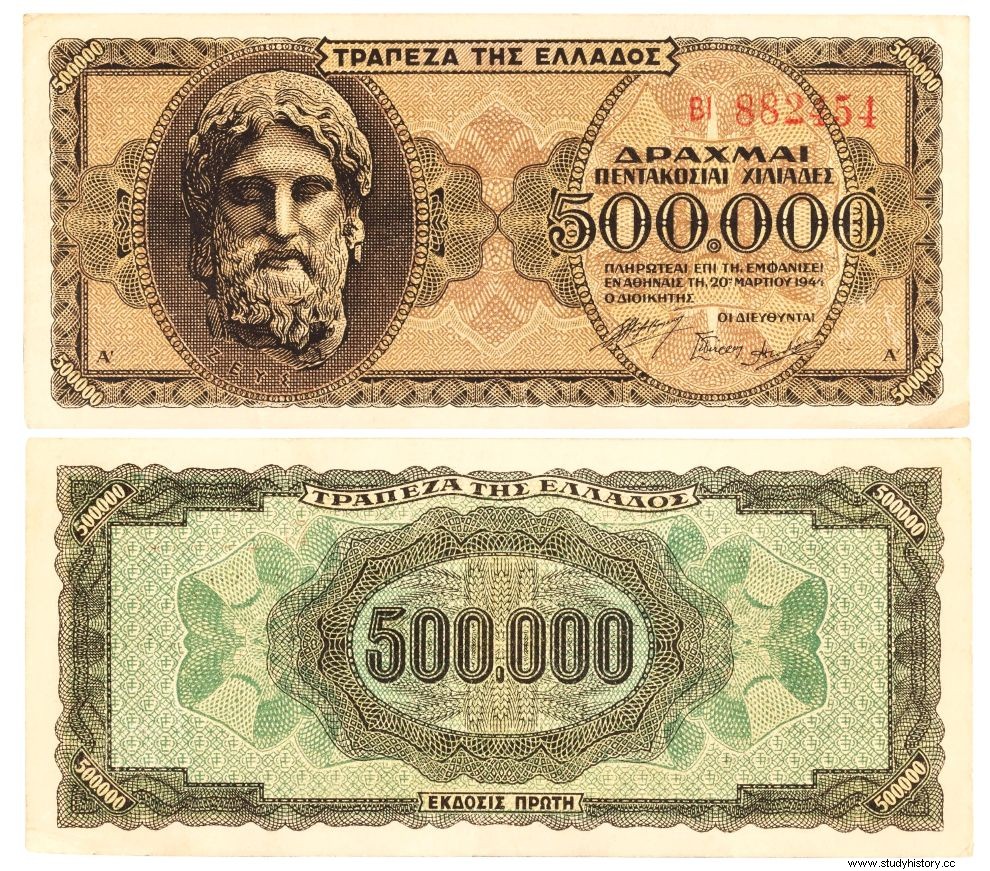
Two years later, in 1935, banknotes of 50, 100 and 1,000 drachmas were printed in France with a very different aesthetic, rich in colors and without heavy borders. In 1938, the "Banknote and Securities Printing Foundation", our well-known Mint, was founded, which was entrusted with the care of the composition and the issuance of the banknotes. Construction work on Cholargos began immediately and the first printing presses were ordered, but despite the fact that the building was completed in 1941 due to World War II, its operation began after liberation in 1947.
During the war (1940-44), the drachma experienced the greatest depreciation in its history, under the pressure of the economic collapse of Greece and the hyperinflation created by the conditions of the time. Especially during the period of occupation (1941-44), many banknotes were printed in various lithographies of the country with enormous denominations, but whose exchange value was negligible. In November 1944 we had the record banknote, with a nominal value of 100 billion drachmas, whose real value today would not exceed 10 euro cents!
THE POST-WAR DRACHMA AND THE MINT
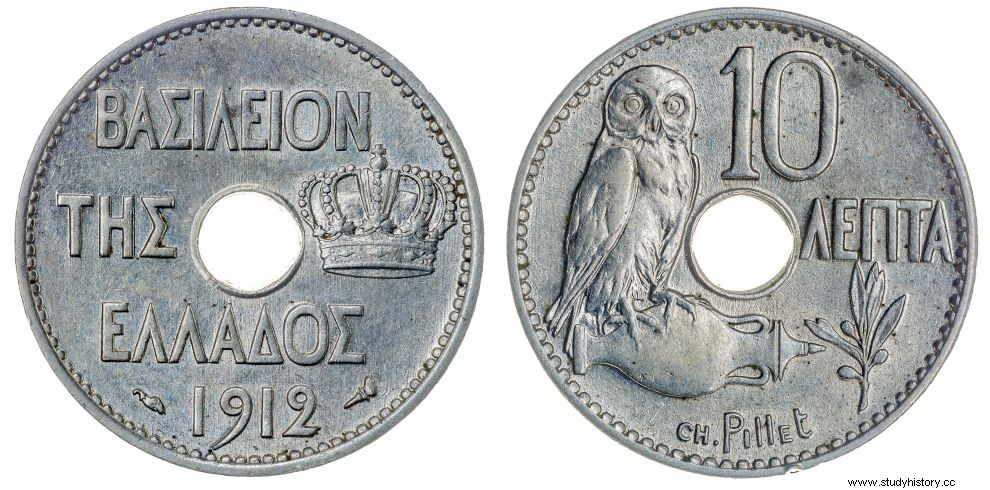
Two monetary reforms followed, so that Greece once again had a stable currency. The first, in November 1944, provided that each new drachma was equivalent to 50 billion occupation drachmas. With the second one, in 1954, the exchange rate changed and the new drachma now corresponded to 1,000 old drachmas, while one US dollar corresponded to 30 new drachmas. With the enthronement of King Paulus in 1947, the 1,000 drachma banknote was printed with Theodoros Kolokotronis.
The first banknote studied, prepared and printed entirely at IETA was that of 5,000 drachmas (4th edition), which depicted the national poet Dionysios Solomos. Until the end of Paul's reign, in 1964, various coins were minted, all crafted by the engraver Vasilios Falireas. With the enthronement of Constantine II, the IETA initiated a new practice for banknotes, sorting them by size according to their value and specifying a specific theme and color for each value.
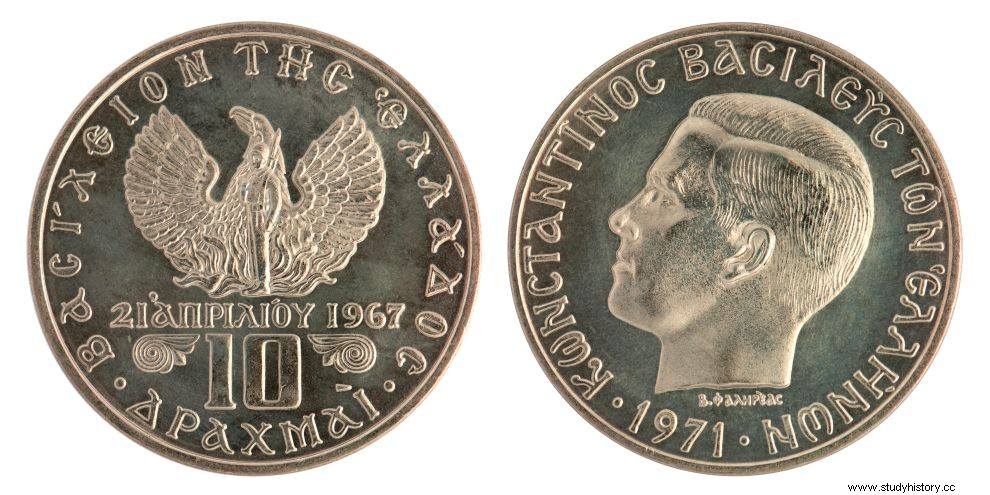
Thus, the 50-drachma note, the smallest in size, was light blue and included in the thematic section "Shipping", the 100-drachma note was red and had the theme of "Education", the 200-drachma note was orange and had the theme of "Enlightenment", the 500 drachma was green and had a "Georgia" theme, the 1,000 drachma was brown and had a "Tourism" theme, the 5,000 drachma was blue and had a "Revolution of 1821" theme and finally, the 10,000 drachma had a violet color and theme "Science and Health".
The coins minted at that time had on one side the portrait of the king and on the other the royal coat of arms, until 1971, when it was replaced by the emblem of April 21, 1967, our familiar "bird". In the same year, 1971, the Coin Printing Department started operating at IETA. After the post-colonization of 1974, the first coins were minted in 1976 and the first banknotes were printed in 1978. The period of exchange of drachma banknotes with euros by the Bank of Greece ended on March 1, 2012.
THE LATEST COINS OF THE DRACHMA

Let us now remember which were the last coins and which were the last banknotes that circulated in Greece, before the abolition of the drachma. Let's start with the coins.
- Coin of 50 cents
- Year of first release:1976
- Side A':50 minutes, Hellenic Republic
- Side B':Markos Botsaris
- 1 drachma coin
- Year of first release:1988
- Side A':Ship of 1821 "Corvette"
- Side B':Laskarina Boubulina
- Coin of 2 drachmas
- Year of first release:1988
- Side A':Naval symbol of 1821
- Side B':Manto Mavrogenous
- Coin of 5 drachmas
- Year of first release:1976
- Side A':Nominal value
- Side B':Aristotle
- Coin of 10 drachmas
- Year of first release:1976
- Side A':Symbol of person
- Side B':Democritus
- Coin of 20 drachmas
- Year of first release:1990
- Όψη Α':Κλαδί ελιάς
- Όψη Β':Διονύσιος Σολωμός
- Κέρμα 50 δραχμών
- Έτος πρώτης κυκλοφορίας:1986
- Όψη Α':Αρχαϊκό ελληνικό πλοίο
- Όψη Β':Όμηρος
- Κέρμα 100 δραχμών
- Έτος πρώτης κυκλοφορίας:1990
- Όψη Α':Άστρο Βεργίνας
- Όψη Β':Μέγας Αλέξανδρος
ΤΑ ΤΕΛΕΥΤΑΙΑ ΧΑΡΤΟΝΟΜΙΣΜΑΤΑ ΤΗΣ ΔΡΑΧΜΗΣ
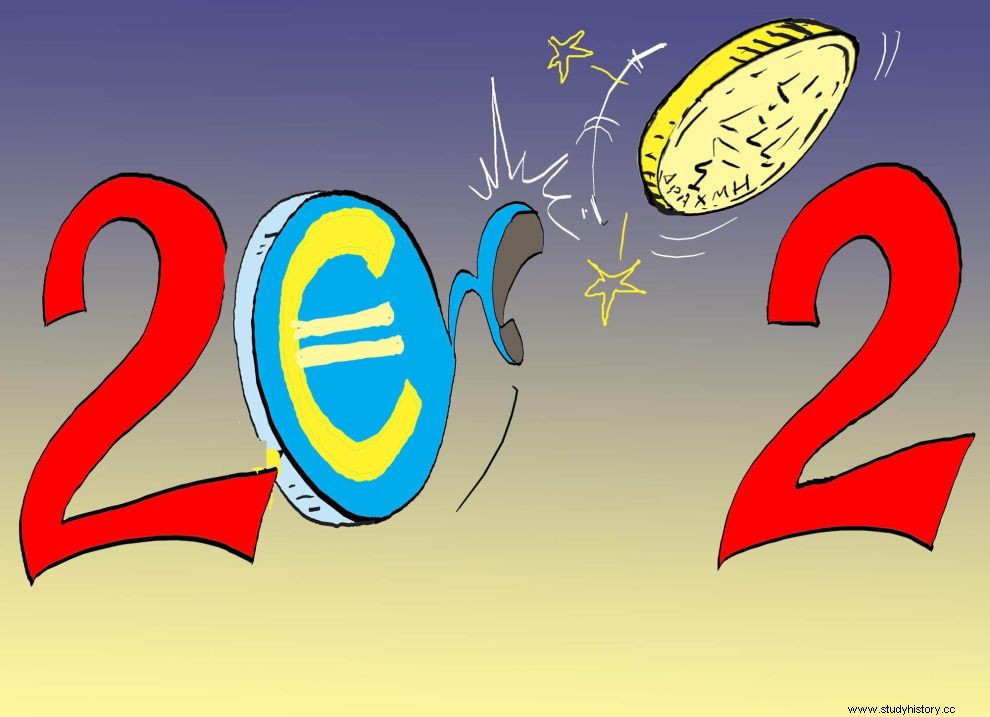
Και ολοκληρώνουμε με τα τελευταία χαρτονομίσματα πριν την κατάργηση της δραχμής.
- Τραπεζογραμμάτιο 100 δραχμών
- Ημερομηνία έκδοσης:8 Δεκεμβρίου 1978
- Κύρια παράσταση, όψη Α':Κεφαλή θεάς Αθηνάς
- Κύρια παράσταση, όψη Β':Αδαμάντιος Κοραής
- Χρώμα:Κόκκινο
- Ασφάλεια χαρτιού:Υδατογράφημα, κεφαλή Ηνίοχου των Δελφών
- Τραπεζογραμμάτιο 200 δραχμών
- Ημερομηνία έκδοσης:2 Σεπτεμβρίου 1996
- Κύρια παράσταση, όψη Α':Ρήγας Φεραίος
- Κύρια παράσταση, όψη Β':"Κρυφό σχολειό", ελαιογραφία Νικολάου Γύζη
- Χρώμα:Πορτοκαλί
- Ασφάλεια χαρτιού:Υδατογράφημα, κεφαλή Φιλίππου Β'
- Τραπεζογραμμάτιο 500 δραχμών
- Ημερομηνία έκδοσης:1 Φεβρουαρίου 1983
- Κύρια παράσταση, όψη Α':Ιωάννης Καποδίστριας
- Κύρια παράσταση, όψη Β':Φρούριο της πόλης της Κέρκυρας
- Χρώμα:Πράσινο
- Ασφάλεια χαρτιού:Υδατογράφημα, κεφαλή Ηνίοχου των Δελφών
- Τραπεζογραμμάτιο 1.000 δραχμών
- Ημερομηνία έκδοσης:1 Ιουλίου 1987
- Κύρια παράσταση, όψη Α':Κεφαλή θεού Απόλλωνα
- Κύρια παράσταση, όψη Β':Ναός της Ήρας (Αρχαία Ολυμπία) &ο Δισκοβόλος του Μύρωνα
- Χρώμα:Καστανό
- Ασφάλεια χαρτιού:Υδατογράφημα, κεφαλή Ηνίοχου των Δελφών
- Τραπεζογραμμάτιο 5.000 δραχμών
- Ημερομηνία έκδοσης:1 Ιουνίου 1997
- Κύρια παράσταση, όψη Α':Θεόδωρος Κολοκοτρώνης
- Κύρια παράσταση, όψη Β':Τοπίο της Καρύταινας
- Χρώμα:Βαθυκύανο
- Ασφάλεια χαρτιού:Υδατογράφημα, κεφαλή Φιλίππου Β'
- Τραπεζογραμμάτιο 10.000 δραχμών
- Ημερομηνία έκδοσης:16 Ιανουαρίου 1995
- Κύρια παράσταση, όψη Α':Γεώργιος Παπανικολάου
- Κύρια παράσταση, όψη Β':Ασκληπιός
- Χρώμα:Ιώδες
- Ασφάλεια χαρτιού:Υδατογράφημα, κεφαλή Φιλίππου Β'

Αυτή ήταν μια σύντομη παρουσίαση της ιστορίας της δραχμής, από τον 7ο π.Χ. αιώνα, μέχρι και την 3η Μαρτίου του 2002, όταν έπεσε οριστικά η αυλαία για το νόμισμα που κάλυψε μια πορεία 2.700 χρόνων, από την αρχαιότητα μέχρι και τις μέρες μας. Σήμερα, στα περισσότερα ελληνικά σπίτια υπάρχουν κάπου παραπεταμένα, φυλαγμένα ή ξεχασμένα κάποια παλιά κέρματα, για να θυμίζουν αλλοτινά χρόνια, από την τρύπια δεκάρα και το θρυλικό πενηνταράκι, μέχρι το χάρτινο - απόλυτο χαρτζηλίκι της δικής μου εφηβείας - πενηντάρικο και το δίφραγκο ή το τάληρο που έμπαιναν στα κόκκινα τηλέφωνα των περιπτέρων, απομεινάρια όλα τους μιας άλλης εποχής που έφυγε ανεπιστρεπτί...
